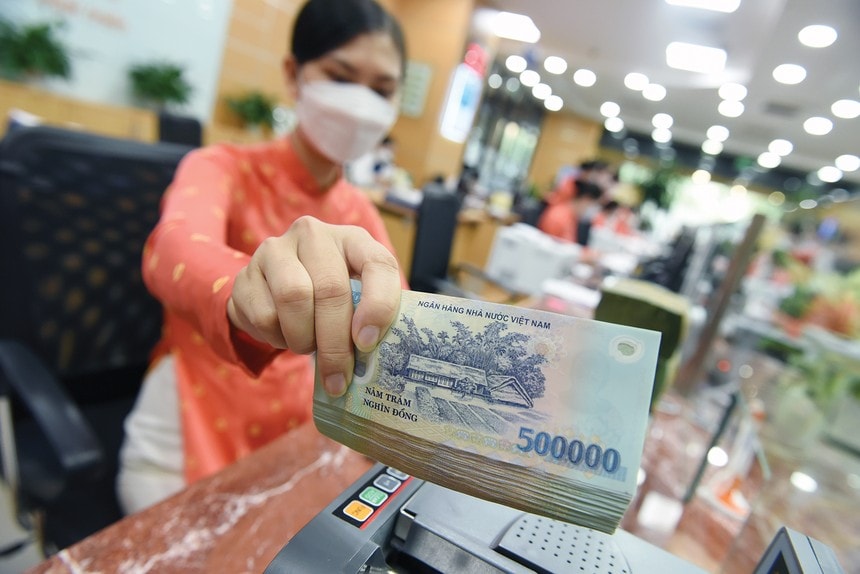Although Vietnam's economy still depends heavily on credit, according to experts, high leverage is not a problem if capital is allocated to the right target and used effectively.
Credit growth is rapid but has not created hot pressure
By the end of June 2025, system-wide credit had increased by nearly 10%, 2.5 times higher than the same period last year, according to data from the State Bank of Vietnam (SBV). In the context of the Government adjusting the GDP growth target from 8% to 8.3-8.5%, the requirement is that credit must increase by 18-20% to ensure sufficient momentum for the economy.
By the end of 2024, Vietnam's credit balance to GDP ratio will have reached about 134%. If the credit expansion rate continues this year, the financial leverage ratio will continue to increase. The International Monetary Fund (IMF) has repeatedly warned that Vietnam is over-reliant on bank credit and recommended that this dependence should be gradually reduced.
However, Mr. Pham Xuan Hoe, General Secretary of the Vietnam Financial Leasing Association and former Director of the Banking Strategy Institute, said that rapid credit growth is not necessarily a risk if capital is allocated in the right direction.
“Credit increased by 10% in the first half of the year, and is expected to increase by 20% for the whole year to meet the GDP growth target of 8.5%. With credit leverage being twice the current GDP, in the context of the specific nature of the Vietnamese economy, especially the high ICOR coefficient, this is not yet a sign of hot growth,” Mr. Hoe commented.
During the 2008–2021 period, credit grew rapidly, with the growth rate four times higher than GDP growth. Compared to that time, the current doubling rate is considered appropriate to the scale and development characteristics of the economy.
In 2025, the State Bank targets credit growth at 16%. However, the regulator also left open the possibility of expanding the room to 18% if inflation is well controlled, equivalent to injecting more than VND3 trillion into the economy.
According to experts, if this capital flow is directed to priority sectors such as manufacturing, processing and manufacturing industry, infrastructure, clean energy, etc., it will not create asset bubbles or push up interest rates and inflation.
On the contrary, if credit continues to flow strongly into speculative sectors such as real estate, securities, or high-risk consumer loans, the risk of asset bubbles and bad debt will exist, threatening macroeconomic stability.
Associate Professor Dr. Nguyen Huu Huan (Ho Chi Minh City University of Economics) analyzed: “If credit capital is regulated reasonably, an increase of only about 17-18% is enough to meet the GDP growth requirement of 8.3-8.5%. However, if capital flows are sucked into speculative activities, credit must increase beyond the 20% mark to achieve the growth target, accompanied by greater long-term consequences.”
Experts say that the IMF’s recommendation that Vietnam should reduce credit leverage is theoretically sound. However, in reality, the Vietnamese economy still relies mainly on bank credit because the other two capital channels – the bond and stock markets – are still weak and not strong enough to share the burden. Tightening credit in this context could cause “blockages” in capital flows and slow down economic recovery.
Not to mention, in recent years, the banking system has pumped an average of VND2 trillion into the economy each year. However, if we exclude debt restructuring loans mainly in the real estate sector, the actual credit serving production, investment and effective consumption has not increased as strongly as the surface statistics show.

Bank capital buffer is still weak, posing many risks
According to Mr. Nguyen Quang Ngoc, Deputy Head of Credit Policy Department of Agribank , in credit granting activities, banks always proactively develop many operational scenarios, ensuring both adequate capital for the economy and tight risk control.
“We cannot be swept away by waves of credit growth arbitrarily. The bank always strictly adheres to capital safety ratios and directs credit flows to priority areas,” Mr. Ngoc affirmed.
In fact, after many years of restructuring, the financial health of the banking system has seen positive changes. Capital buffers have been strengthened, many weak banks have been forced to transfer, the ability to withstand systemic risks has also improved significantly, and the bad debt ratio has decreased sharply.
Credit growth in the first half of 2025 was quite rapid, but market liquidity remained abundant and interest rates remained low. According to the assessment, the State Bank of Vietnam has enough room to manage credit growth by about 10% in the second half of the year without creating pressure to unbalance the system.
In addition, the SBV currently possesses many technical tools to control credit risks. For example, in the real estate sector, which is inherently risky if capital flows in massively, the SBV can adjust the risk coefficient up to 300%. This forces banks to increase their equity capital to be eligible to expand lending, thereby indirectly tightening real estate credit.
However, high credit growth does not mean there is no longer any concern. The core problem today, according to experts, is that the capital buffer of the banking system is still too thin, a weak point that is vulnerable if an economic or financial shock occurs. Currently, the average capital adequacy ratio (CAR) of Vietnamese banks is only about 12%, significantly lower than the standards of many countries in the region.
Mr. Nguyen Quang Thuan, Chairman of FiinGroup, warned that the biggest risk in the banking industry today is the rapid credit growth while the capital base has not been strengthened accordingly. According to him, commercial banks, especially the Big 4 group, need to proactively improve their financial capacity and strengthen their capital buffer to protect the system from unexpected fluctuations.
Recently, the State Bank of Vietnam issued Circular 14/2025/TT-NHNN, clearly stipulating new capital buffer requirements, requiring banks to increase equity capital, limit lending to high-risk sectors and improve internal control efficiency.
This circular is considered an important step towards removing the credit “room” mechanism. Accordingly, commercial banks that meet Basel III capital safety standards can have their credit growth ceiling completely removed. On the contrary, banks with weak financial capacity and insufficient capital buffers will continue to be tightly controlled by the State Bank.
Source: https://baolamdong.vn/neu-dong-tin-dung-duoc-phan-bo-dung-muc-tieu-rui-ro-se-duoc-kiem-soat-384200.html



































































































Comment (0)